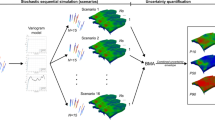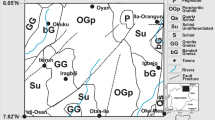Abstract
This study introduces Bayesian model averaging (BMA) to deal with model structure uncertainty in groundwater management decisions. A robust optimized policy should take into account model parameter uncertainty as well as uncertainty in imprecise model structure. Due to a limited amount of groundwater head data and hydraulic conductivity data, multiple simulation models are developed based on different head boundary condition values and semivariogram models of hydraulic conductivity. Instead of selecting the best simulation model, a variance-window-based BMA method is introduced to the management model to utilize all simulation models to predict chloride concentration. Given different semivariogram models, the spatially correlated hydraulic conductivity distributions are estimated by the generalized parameterization (GP) method that combines the Voronoi zones and the ordinary kriging (OK) estimates. The model weights of BMA are estimated by the Bayesian information criterion (BIC) and the variance window in the maximum likelihood estimation. The simulation models are then weighted to predict chloride concentrations within the constraints of the management model. The methodology is implemented to manage saltwater intrusion in the “1,500-foot” sand aquifer in the Baton Rouge area, Louisiana. The management model aims to obtain optimal joint operations of the hydraulic barrier system and the saltwater extraction system to mitigate saltwater intrusion. A genetic algorithm (GA) is used to obtain the optimal injection and extraction policies. Using the BMA predictions, higher injection rates and pumping rates are needed to cover more constraint violations, which do not occur if a single best model is used.










Similar content being viewed by others
References
Abarca E, Vazquez-Sune E, Carrera J, Capino B, Gamez D, Batlle F (2006) Optimal design of measures to correct seawater intrusion. Water Resour Res 42(9):W09415. doi:10.1029/2005WR004524
Ahlfeld DP, Heidari M (1994) Applications of optimal hydraulic control to groundwater systems. J Water Resour Plan Manag - ASCE 120(3):350–365
Aly AH, Peralta RC (1999) Optimal design of aquifer cleanup systems under uncertainty using a neural network and a genetic algorithm. Water Resour Res 35(8):2523–2532
Baú DA, Mayer AS (2008) Optimal design of pump-and-treat systems under uncertain hydraulic conductivity and plume distribution. J Contam Hydrol 100(1–2):30–46
Bayer P, Finkel M (2004) Evolutionary algorithms for the optimization of advective control of contaminated aquifer zones. Water Resour Res 40(6):W06506. doi:10.1029/2003WR002675
Bayer P, Finkel M (2007) Optimization of concentration control by evolution strategies: formulation, application, and assessment of remedial solutions. Water Resour Res 43(2):W02410. doi:10.1029/2005WR004753
Bense VF, Person MA (2006) Faults as conduit-barrier systems to fluid flow in siliciclastic sedimentary aquifers. Water Resour Res 42(5):W05421. doi:10.1029/2005WR004480
Beven K, Binley A (1992) The future of distributed models: model calibration and uncertainty prediction. Hydrol Process 6(3):279–298
Beven K, Freer J (2001) Equifinality, data assimilation, and uncertainty estimation in mechanistic modelling of complex environmental systems using the GLUE methodology. J Hydrol 249(1–4):11–29
Bray RB, Hanor JS (1990) Spatial variations in subsurface pore fluid properties in a portion of Southeast Louisiana: implications for regional fluid flow and solute transport. Gulf Coast Assoc Geol Soc Trans XL, 53–64
Byrd RH, Lu P, Nocedal J, Zhu C (1994) A limited memory algorithms for bound constrained optimization. Northwestern University, Department of Electrical Engineering and Computer Science, Technical Report NAM-08
CAGWCC (2002) Conserve ground water our greatest natural resource, Capital Area Ground Water Conservation Commission. Newsletter 27(3), 4 pp
Carrera J, Neuman SP (1986a) Estimation of aquifer parameters under transient and steady-state conditions 1. Maximum likelihood method incorporating prior information. Water Resour Res 22(2):199–210
Carrera J, Neuman SP (1986b) Estimation of aquifer parameters under transient and steady-state conditions 3. Application to synthetic and field data. Water Resour Res 22(2):228–242
Carroll DL (1996) Chemical laser modeling with genetic algorithms. AIAA J 34(2):338–346
Chan N (1993) Robustness of the multiple realization method for stochastic hydraulic aquifer management. Water Resour Res 29(9):3159–3167
Dean S, Freer J, Beven K, Wade AJ, Butterfield D (2009) Uncertainty assessment of a process-based integrated catchment model of phosphorus. Stoch Environ Res Risk Assess 23(7):991–1010
Dettinger MD, Wilson JL (1981) First-order analysis of uncertainty in numerical-models of groundwater flow Part 1. Mathematical development. Water Resour Res 17(1):149–161
Draper D (1995) Assessment and propagation of model uncertainty. J R Stat Soc Ser B 57(1):45–97
Eggleston JR, Rojstaczer SA, Peirce JJ (1996) Identification of hydraulic conductivity structure in sand and gravel aquifers: Cape Cod data set. Water Resour Res 32(5):1209–1222
Feyen L, Gorelick SM (2004) Reliable groundwater management in hydroecologically sensitive areas. Water Resour Res 40(7):W07408. doi:10.1029/2003WR003003
Feyen L, Gorelick SM (2005) Framework to evaluate the worth of hydraulic conductivity data for optimal groundwater resources management in ecologically sensitive areas. Water Resour Res 41(3):W03019. doi:10.1029/2003WR002901
Feyen L, Beven KJ, De Smedt F, Freer J (2001) Stochastic capture zone delineation within the generalized likelihood uncertainty estimation methodology: conditioning on head observations. Water Resour Res 37(3):625–638
Feyen L, Ribeiro PJ, De Smedt F, Diggle PJ (2003) Stochastic delineation of capture zones: classical versus Bayesian approach. J Hydrol 281(4):313–324
Foglia L, Mehl SW, Hill MC, Perona P, Burlando P (2007) Testing alternative ground water models using cross-validation and other methods. Ground Water 45(5):627–641
Georgakakos AP, Vlatsa DA (1991) Stochastic control of groundwater systems. Water Resour Res 27(8):2077–2090
Gorelick SM (1983) A review of distributed parameter groundwater-management modeling methods. Water Resour Res 19(2):305–319
Guan J, Aral MM (1999) Optimal remediation with well locations and pumping rates selected as continuous decision variables. J Hydrol 221(1–2):20–42
Guan JB, Kentel E, Aral MM (2008) Genetic algorithm for constrained optimization models and its application in groundwater resources management. J Water Resour Plan Manage - ASCE 134(1):64–72
Harbaugh AW, Banta ER, Hill MC, McDonald MG (2000) MODFLOW-2000, The U.S. Geological Survey modular ground-water model: user guide to modularization concepts and the ground-water flow process. U.S. Geological Survey Open-File Report 00-92
Hassan AE, Bekhit HM, Chapman JB (2008) Uncertainty assessment of a stochastic groundwater flow model using GLUE analysis. J Hydrol 362(1–2):89–109
Hoeting JA, Madigan D, Raftery AE, Volinsky CT (1999) Bayesian model averaging: a tutorial. Statistical Science 14(4):382–401
Hsieh PA, Freckleton JR (1993) Documentation of a computer program to simulate horizontal-flow barriers using the U.S. Geological Survey’s modular three-dimensional finite-difference ground-water flow model, U.S. Geological Survey, Open-File Report 92-477.
Hyun Y, Lee KK (1998) Model identification criteria for inverse estimation of hydraulic parameters. Ground Water 36(2):230–239
Ko NY, Lee KK (2009) Convergence of deterministic and stochastic approaches in optimal remediation design of a contaminated aquifer. Stoch Env Res Risk Assess 23(3):309–318
Li X (2008) Bayesian model averaging on hydraulic conductivity estimation and groundwater head prediction. Ph.D. Dissertation, Louisiana State University, Baton Rouge, Louisiana
Li X, Tsai FT-C (2009) Bayesian model averaging for groundwater head prediction and uncertainty analysis using multimodel and multimethod. Water Resour Res 45:W09403. doi:10.1029/2008WR007488
Madigan D, Andersson SA, Perlman MD, Volinsky CT (1996) Bayesian model averaging and model selection for Markov equivalence classes of acyclic digraphs. Communications in Statistics-Theory and Methods 25(11):2493–2519
Mahesha A (1996) Control of seawater intrusion through injection-extraction well system. J Irrig Drain Eng - ASCE 122(5):314–317
Mantoglou A (2003) Estimation of heterogeneous aquifer parameters from piezometric data using ridge functions and neural networks. Stoch Env Res Risk Assess 17(5):339–352
Mayer AS, Kelley CT, Miller CT (2002) Optimal design for problems involving flow and transport phenomena in saturated subsurface systems. Adv Water Resour 25(8–12):1233–1256
McKinney DC, Lin MD (1994) Genetic algorithm solution of groundwater-management models. Water Resour Res 30(6):1897–1906
Minsker BS, Shoemaker CA (1998) Dynamic optimal control of in situ bioremediation of ground water. J Water Resour Plan Manag - ASCE 124(3):149–161
Morgan DR, Eheart JW, Valocchi AJ (1993) Aquifer remediation design under uncertainty using a new chance constrained programming technique. Water Resour Res 29(3):551–561
National Research Council (2001) Conceptual models of flow and transport in the fractured vadose zone. National Academic Press, Washington, DC
Neuman SP (2003) Maximum likelihood Bayesian averaging of uncertain model predictions. Stoch Env Res Risk Assess 17(5):291–305
Oliver LD, Christakos G (1996) Boundary condition sensitivity analysis of the stochastic flow equation. Adv Water Resour 19(2):109–120
Ortiz CJ, Deutsch CV (2002) Calculation of uncertainty in the variogram. Math Geol 34(2):169–183
Park CH, Aral MM (2004) Multi-objective optimization of pumping rates and well placement in coastal aquifers. J Hydrol 290(1–2):80–99
Poeter E, Anderson D (2005) Multimodel ranking and inference in ground water modeling. Ground Water 43(4):597–605
Raftery AE (1995) Bayesian model selection in social research. Sociol Methodol 25:111–163
Rahman A, Tsai FT-C, White CD, Carlson DA, Willson CS (2008a) Geophysical data integration, stochastic simulation and significance analysis of groundwater responses using ANOVA in the Chicot Aquifer system, Louisiana, USA. Hydrogeol J 16(4):749–764
Rahman A, Tsai FT-C, White CD, Willson CS (2008b) Coupled semivariogram uncertainty of hydrogeological and geophysical data on capture zone uncertainty analysis. J Hydrol Eng - ASCE 13(10):915–925
Ranjithan S, Eheart JW, Garrett JH (1993) Neural network based screening for groundwater reclamation under uncertainty. Water Resour Res 29(3):563–574
Reichard EG, Johnson TA (2005) Assessment of regional management strategies for controlling seawater intrusion. J Water Resour Plan Manag - ASCE 131(4):280–291
Russo D (1988) Determining soil hydraulic properties by parameter estimation: on the selection of a model for the hydraulic-properties. Water Resour Res 24(3):453–459
Singh A, Minsker BS (2008) Uncertainty-based multiobjective optimization of groundwater remediation design. Water Resour Res 44(2):W02404. doi:10.1029/2005WR004436
Smalley JB, Minsker BS, Goldberg DE (2000) Risk-based in situ bioremediation design using a noisy genetic algorithm. Water Resour Res 36(10):3043–3052
Tolson BA, Shoemaker CA (2008) Efficient prediction uncertainty approximation in the calibration of environmental simulation models. Water Resour Res 44(4):W04411. doi:10.1029/2007WR005869
Tomaszewski DJ (1996) Distribution and movement of saltwater in aquifers in the Baton Rouge area, Louisiana, 1990–1992. Louisiana Department of Transportation and Development Water Resources Technical Report No. 59
Tsai FT-C (2006) Enhancing random heterogeneity representation by mixing the kriging method with the zonation structure. Water Resour Res 42(8):W08428. doi:08410.01029/02005WR004111
Tsai FT-C, Li X (2008a) Inverse groundwater modeling for hydraulic conductivity estimation using Bayesian model averaging and variance window. Water Resour Res 44(9):W09434. doi:10.1029/2007WR006576
Tsai FT-C, Li X (2008b) Multiple parameterization for hydraulic conductivity identification. Ground Water 46(6):851–864
Tsai FT-C, Yeh WW-G (2004) Characterization and identification of aquifer heterogeneity with generalized parameterization and Bayesian estimation. Water Resour Res 40:W10102. doi:10.1029/2003WR002893
Tung YK (1986) Groundwater management by chance-constrained model. J Water Resour Plan Manag - ASCE 112(1):1–19
USEPA (1997) Guiding principles for Monte Carlo analysis. U.S. Environmental Protection Agency, EPA/630/R-97/001
Wagner BJ (1995) Recent advances in simulation-optimization groundwater management modeling. Rev Geophys 33:1021–1028
Wagner BJ, Gorelick SM (1987) Optimal groundwater quality management under parameter uncertainty. Water Resour Res 23(7):1162–1174
Wagner BJ, Gorelick SM (1989) Reliable aquifer remediation in the presence of spatially variable hydraulic conductivity: from data to design. Water Resour Res 25(10):2211–2225
Wagner JM, Shamir U, Nemati HR (1992) Groundwater quality management under uncertainty: stochastic programming approaches and the value of information. Water Resour Res 28(5):1233–1246
Watkins DW, McKinney DC (1997) Finding robust solutions to water resources problems. J Water Resour Plan Manag - ASCE 123(1):49–58
Ye M, Neuman SP, Meyer PD (2004) Maximum likelihood Bayesian averaging of spatial variability models in unsaturated fractured tuff. Water Resour Res 40(5):W05113. doi:10.1029/2003WR002557
Yeh WW-G (1992) Systems analysis in groundwater planning and management. J Water Resour Plan Manag - ASCE 118(3):224–237
Zheng C, Wang P (1999) MT3DMS, A modular three-dimensional multispecies transport model for simulation of advection, dispersion and chemical reactions of contaminants in groundwater systems (Release DoD_3.50.A), Documentation and User’s Guide
Acknowledgements
The study was supported in part by the Department of the Interior, U.S. Geological Survey under Grant No. 05HQGR0142 and 06HQGR0088. The views and conclusions contained in the document are those of the author and should not be interpreted as necessarily representing the official policies, either expressed or implied, of the U.S. Government. The author acknowledges Xiaobao Li and Asheka Rahman for their prior input. The constructive reviews were provided by the guest editors Philip Meyer and Ming Ye, and one anonymous reviewer.
Author information
Authors and Affiliations
Corresponding author
Rights and permissions
About this article
Cite this article
Tsai, F.TC. Bayesian model averaging assessment on groundwater management under model structure uncertainty. Stoch Environ Res Risk Assess 24, 845–861 (2010). https://doi.org/10.1007/s00477-010-0382-3
Published:
Issue Date:
DOI: https://doi.org/10.1007/s00477-010-0382-3




